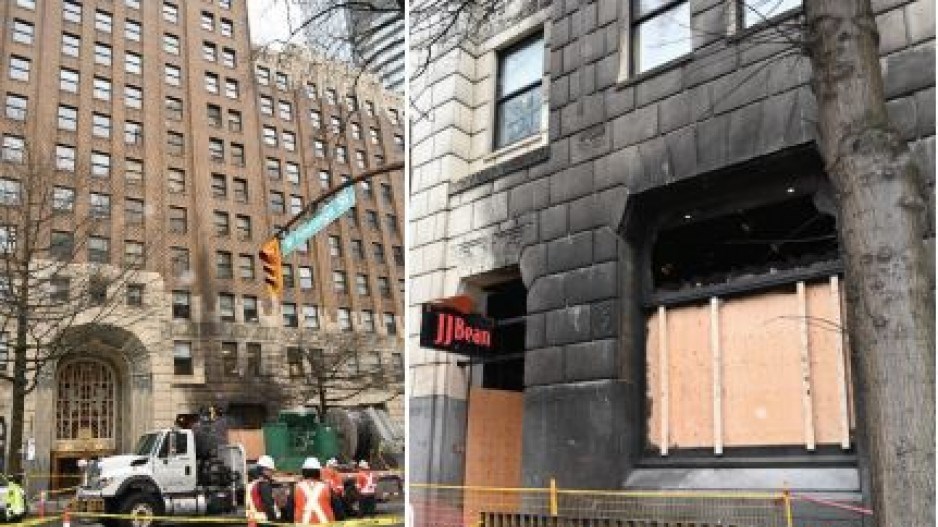The B.C. Utilities Commission (BCUC) is not satisfied with an investigation BC Hydro commissioned into a sub-station fire in February and has ordered another independent investigation into BC Hydro’s safety practices and culture.
On February 24, 2023, around 6 p.m., a BC Hydro underground vault in the 300 block of Burrard Street of Vancouver exploded in fire, injuring two people and causing damage to business.
BC Hydro filed a post-incident report, followed by a supplemental response to BCUC questions, but those reports only raised “serious concerns for the BCUC regarding BC Hydro’s safety practices and culture.”
What seems to be triggering the BCUC’s concern is BC Hydro’s admission that it was well aware of certain safety hazards associated with oil-filled switches, but failed to address the problem.
The underground station on Burrard Street – known as Vault No. 73 – was installed in 1975. The station had two oil-filled switches (commonly called RAL switches) that BC Hydro had identified constitute a fire hazard. The fire was by a citizen and posted on Twitter.
Following the explosion in February, BC Hydro tasked Senez Consulting Ltd. To conduct an investigation. It concluded that the accumulation of combustible gases caused by “contaminated insulating oil” inside the switch was the only possible cause of the explosion and fire.
BC Hydro admits it was aware that these oil-filled switches constituted a fire hazard and a safety risk.
“During our investigation, we determined that serious risks had previously been identified with this equipment in the event of a failure,” BC Hydro CEO Chris O’Riley admits in a report to the BCUC. “In 2016, one of BC Hydro’s aging underground transformers failed and resulted in contaminated oil being released into a vault.”
Following the 2016 incident, BC Hydro conducted a survey of all its other RAL switches and identified 14 that were deemed to be “likely to be in poor condition” and “high risk,” including the one that exploded in February.
“It (the survey) stated that the consequence of not properly maintaining or replacing this equipment could include public or worker severe injury or death,” O’Riley says in his report to the BCUC.
The BC Hydro survey recommended that the RAL switches and transformers be replaced with “modern equipment” in five vaults, including Vault No. 73.
BC Hydro undertook a replacement project for the five vaults, but the one that ended up exploding – No. 73 – was removed from the project scope so that equipment in another vault that was closer in proximity to the other four vaults (in the Gastown area) could be replaced instead.
Inspection and maintenance of Vault No. 73 switches was supposed to have occurred until all RAL switches could be replaced, but that appears not to have happened.
“Our investigation determined that the maintenance the revised plan relied upon was not carried out effectively as a result of gaps in our asset management practices,” O’Riley explains in his report. “Our crews had difficulties performing the proper maintenance, despite their best efforts, because they did not have the proper information and instructions or the correct materials to complete the maintenance work.”
“Our investigation identified concerning gaps in our asset management practices for underground street vaults that contributed to this incident,” O’Riley concludes.
"I am deeply disappointed by these findings, and I sincerely apologize to the individuals and businesses that were injured or impacted because of these shortcomings, to those who live near our assets, and to our employees. The safety and reliability of our electricity system is critical, and I take responsibility, on behalf of BC Hydro, for the failures that occurred. This incident should never have happened.
“I want to be clear that our crews were doing the best they could with the materials, information, and instructions they received. The investigation determined that there was limited information and instructions on required visual inspections and when to replace a gasket, no defined replacement parts, and no end-of-life timing for the gaskets. This left field crews to use incompatible materials . . . to repair the existing gasket when performing maintenance and inspections.”
O’Riley’s report notes that all RAL switches were removed as of April 1 “and no longer present a risk.”
But the BCUC now wants a more fulsome explanation of BC Hydro’s safety practices and culture.
“BC Hydro’s and raise serious concerns for the BCUC regarding BC Hydro’s safety practices and culture,” the BCUC said in a press release.
The BCUC has ordered a third-party investigation, to be submitted by November 30 this year. It directs the investigation to address BC Hydro’s general culture of safety and compliance, its asset management practices, and its procedures and quality control.




